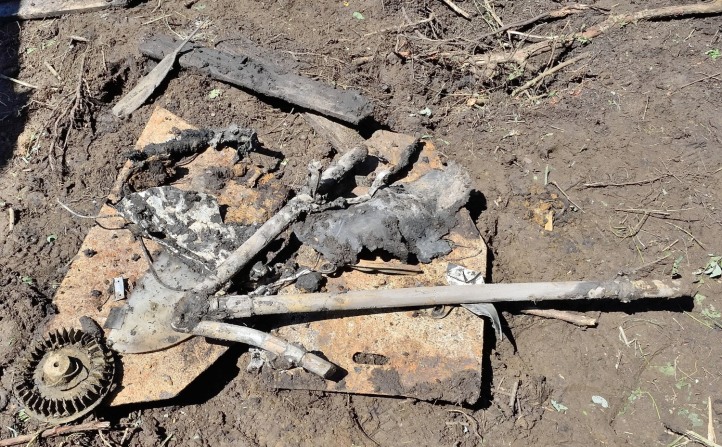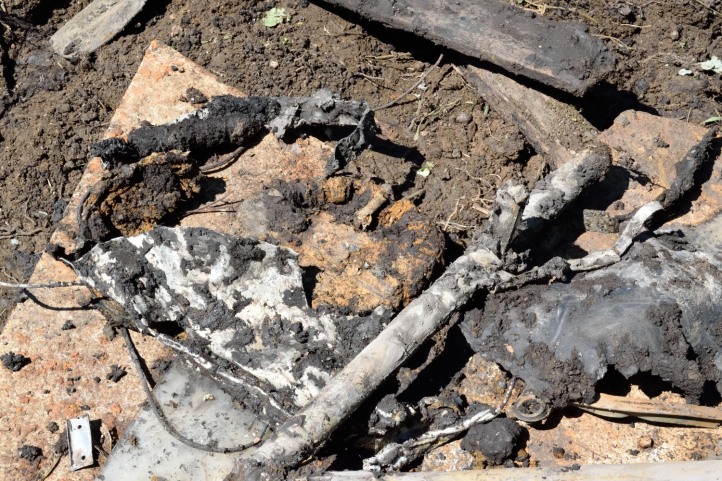Sometimes during filming we find very little, which can be very disheartening for the whole crew, production company, channel AND me! However, sometimes all you need to do to tell a story is find that one little tell-tale relic, that explains everything that you need to prove a chain of events. This was one of those digs.
The Fairey Battle was one of the most notorious aircraft of the second world war. During the invasion of France in 1940, the Battle squadrons suffered incredibly heavy losses during a series of desperate attacks on the German spearhead.
By the time of its first flight, the Battle was always obsolescent, and given the choice the RAF would probably not have ordered large numbers of the type. However, by 1935 the threat posed by the Luftwaffe was becoming clear, and the government wanted to maintain numerical parity with the Germans. The only way to achieve this was to order every possible modern design into mass production. Accordingly the first order for 155 Battles was placed in 1935, well before the first flight of the prototype. Eventually 2,201 Battles were built for the RAF, 1,155 by Fairey, 1029 by the Austin car company as part of the Shadow Factory Scheme and one by Hayes, all to orders placed by the end of 1939. The majority of these aircraft were powered by the Merlin III engine, and are sometimes referred to as Battle IIIs, although this only refers to the type of engine used.
At the outbreak of war, the Battle equipped eight training squadrons in No. 6 Group and ten front line bomber squadrons in No. 1 Group, part of the Advanced Air Striking Force. On 2 September 1939, following a prearranged plan, the ten Fairey Battle Squadrons of No. 1 Group moved to France, in preparation for a possible bombing campaign against the Ruhr. However, this campaign would only begin if the Germans launched a bombing campaign in the west. The Germans had no intention of provoking the western powers while the bulk of their forces were engaged in Poland, and so the western front settled down into the uneasy “phoney war”.
During this period, the Battle was used to fly reconnaissance missions over the German front line. It was during one of these missions, on 20th September 1939 that a Fairey Battle of No. 88 Sq shot down a Messerschmitt 109, giving the Battle the honour of having achieved the first RAF kill of the war. However during this period, the Battle suffered significant losses. It was becoming clear that the bombers were incredibly vulnerable to German fighter planes.
Just how vulnerable the Battle was would become tragically clear after the start of the German Blitzkrieg in the west. The Battle was used to make desperate low level attacks on the advancing German troops. This reduced its vulnerability to the German fighters, but massively increased the numbers being shot down by anti-aircraft fire and even small arms fire.
The pattern was set on 10 May 1940. On the first day of the German assault, 32 Battles were sent out to attack advancing enemy troops and 13 were lost. The next day seven out of the eight Battles dispatched were lost. On 12 May, a force of five Battles were sent to attack crucial bridges over the Albert Canal. All five were lost.
The low level attacks were abandoned in the face of the heavy losses. At first, the new tactics produced success as all ten aircraft sent against the canal bridges returned. However, that afternoon, all 63 remaining Battles were sent against the bridges and 35 were shot down. High losses continued as the Germans broke through the French lines, and on 15th June 1940, the surviving squadrons were withdrawn back to Britain.
The aircraft has been mired by the savagery at which the Germans destroyed them. The aircraft proved disappointing but recently military historians have put more blame on the way the aircraft was used rather than the design itself. They were used as level day bombers which left them incredibly vulnerable. Had the aircraft been used more like the remarkably similar and infinitely more successful Il-2 Shturmovik of the Soviet Air Force then it might have proven more useful.
‘Our’ Battle was sent to bomb German troops crossing the River Seine near Vernon. It had no fighter escort and no German Messerschmitts were in the area – but it had the great misfortune to be attacked by FRENCH fighters who mistook it for an enemy aircraft and shot it down!
The aircraft crashed with the pilot and observer still in it
Pilot Officer Cecil Thomas – aged 19
Sergeant Peter Bligh – aged 20.
Here are some of the letters in the RAF’s Casualty File held at the National Archives: Telegrams were sent to the parents informing them that their sons had not returned from operations, but they might have been taken prisoners.
On 28th July 1940 Cecil Thomas’ mother wrote to the Air Ministry hoping for news:

There was no news of Cecil. His mother wrote again in May 1945 after hearing that the RAF were searching for lost airmen – and apologised for ‘troubling them’


It is awful to know that Esther Thomas died in November 1945, with no more news of her son.
Then in March 1946 a letter was received by the RAF’s Missing Research and Enquiry Unit.

The RAF sent an officer to investigate the report


In January 1947 the recommended exhumation of the grave took place

In May 1947 the Air Ministry wrote to the families

And the family replied

A truly tragic story and one that is all too often repeated in war. A story of friendly fire causing the deaths of your comrades in arms.
The aircraft is believed to have been recovered in ‘chunks’ during the late 40s and early 50s, probably used as scrap by the locals. However, of the items that were left behind, the most important relic, the Vickers K magazine, revealed the truth about what had happened on that fateful day.

















Amazingly though, in among the very small number of finds, the one thing that would end up proving what happened on that fateful day was recovered. A stroke of luck and one that made for a re-writing of history.

I unsderstand the frustration with a lack of finds, but a rather poignant episode nontheless
LikeLike
Fascinating reading the letters, another great piece of research.
LikeLike
I was wondering if you could tell me what happened to the other crew member because it has a crew of 3. Thanks
LikeLike
I can’t remember if we kept it in the final cut or not, but the Battles from 103 SQN flew with only 2 crew members because of the high losses.
LikeLike
Great, thanks for the info.
LikeLike